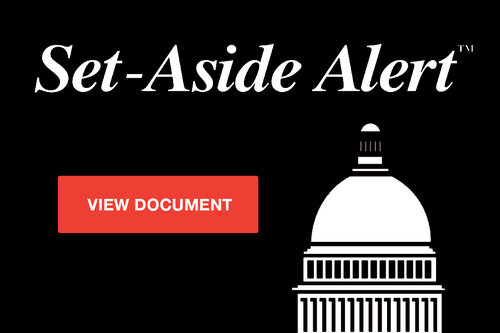by John Hale III, founder and CEO, The Cornerstone Group LLC, and former director, U.S. Dept. of Energy Office of Small and Disadvantaged Business Utilization (OSDBU)
This is the third column in a series on strategies for engaging and leveraging the Office of Small & Disadvantaged Business Utilization (OSDBU). Today’s article builds upon strategies referenced in the July 7 and July 28 editions of the Set-Aside Alert.
It is an understatement to say that today’s federal government marketplace is very competitive and uncertain. The sheer number of firms and contract actions, in conjunction with the shifting political environment and lack of budget clarity, can lead to insomnia. An approach to mitigate these risks and challenges is to engage and cultivate relationships with a federal agency’s OSDBU. The OSDBU serves as an influencer, connector, and enabler of businesses winning government contracts.
Federal agencies sponsor a large number of industry days, conferences, matchmaking events, and other outreach events. The OSDBU staff usually plays a leading role in the planning and execution of these events. Unfortunately, these events can seem overwhelming or appear to be a “cattle call” from the industry’s perspective. Likewise, it can be difficult for an OSDBU team to focus on your company and what you provide. The following are five practical steps companies should utilize to focus OSDBU attention. They are straightforward; however, they are not put to use by many companies.
Be Specific
Define why you are targeting specific outreach events, agencies, their mission(s) and contract opportunities. It is essential your answer moves beyond the basics, i.e., that the agency maintains a large budget, is politically popular, your competitors work there, etc.
Additionally, what is your specific ask of the OSDBU team and how are you making it easy for them to assist you?
Refer to the previous articles for strategic approaches to uncover agency challenges and current priorities.
Customize your elevator pitch and capability statement
This step is the number one way to distinguish yourself in 300 seconds. Based on my experience, approximately one-in-twelve (8.3%) of businesses invested the time and effort to customize their firm’s expertise to the Energy Department. Forwarding a standard and generic capability statement or marketing materials is a quick way to the bottom of the pile. Accordingly, distinguish yourself by:
-
Demonstrating and stating how your firm’s expertise is in alignment with the agency’s mission(s), and/or with specific contract actions. Highlight past performance inclusive of federal, state, local and commercial sectors.
-
Passing the “at a glance test.” This means your conversation and language should be concise and your materials succinct and not cluttered with non-essential information. Remember that at an outreach event the OSDBU team will meet dozens of firms and have only a couple of minutes (at most) to focus on you and your company.
-
The elevator pitch and materials should indicate your proposed solutions to the agency’s challenges. Most people will appreciate you invested the time to understand some of their challenges and to craft a proposed solution.
Business Cards
A major frustration, as a former OSDBU director, is meeting a talented business owner at an event, with an unusable business card. This significantly hindered my ability to advocate on their behalf. Therefore, do not use business cards with the following characteristics:
-
Avoid laminating your business cards because it makes them very difficult to write on.
-
Avoid having no available space on your card. This prevents the
OSDBU and others from writing notes on your card to follow-up on your behalf. -
Avoid a picture of people on your card (my personal preference). This is a distraction and your look s and appearance are not usually factors in winning additional contracts.
Strategic Alliances
Strategic alliances are mutually-vetted relationships with a commitment to collaborate for both parties’ benefit, with the goal of winning additional contracts. These are firms that complement and enhance your services or products. For instance, the strategic alliances could be with mentors or protégés; with firms in socioeconomic categories other than your own; or with companies in other states or countries. The strategic alliances should address the targeted agencies’ mission(s) and contract actions.
Resources – Appear bigger and mitigate federal risks
Focus on communicating and demonstrating your firm’s access to additional financial support (line of credit, grants, etc.), people (technical expertise and capacity), and products or services. Federal customers view the scalability of their contractors as a key component of mitigating their risk – perceived or actual.
John Hale III is founder and CEO of The Cornerstone Group, LLC (TCSG) a consultancy that provides strategic advice for businesses to achieve their near- and long-term goals and win additional contracts/grants. Mr. Hale also serves as vice president of the National Contract Management Association, Bethesda Chapter. Prior to founding TCSG, Mr. Hale served as the U.S. Energy Department’s OSDBU Director and the U.S. SBA’s Deputy Associate Administrator for Capital Access. Mr. Hale can be reached at .


